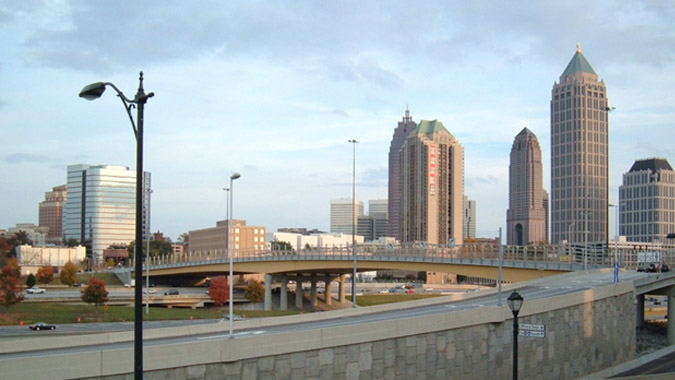| Location |
Atlanta, Georgia |
| Project Sponsor / Borrower |
Georgia Department of Transportation |
| Program Areas |
 |
| Value Capture Techniques |
Private Contribution
Tax Increment Financing |
| Mode |
Bridge |
| Description |
The Atlantic Station 17th Street Bridge is a critical component of a major redevelopment known as Atlantic Station, located on a former brownfield site in the northwest part of downtown Atlanta. The bridge links the redevelopment site with Midtown Atlanta, crossing the I-75/I-85 Connector, which bisects that portion of the city. The bridge provides connections between Northside Drive and Peachtree Street, as well as direct pedestrian access to the Metropolitan Atlanta Rapid Transit Authority (MARTA) Arts Center rail station. The bridge includes:
- Two 11-foot wide lanes in each direction serving automobiles, buses, and trucks
- Two 16-foot wide dedicated bicycle and transit lanes
- A 24-foot wide pedestrian park and thoroughfare on the south side of the bridge containing landscaping, as well as a covered sidewalk on the north side of the bridge
Expected increases in local tax proceeds due to the redevelopment of the brownfield site - the former Atlantic Steel Mil - prompted the city to create the Atlantic Steel Brownfield Redevelopment Plan and Tax Allocation District (ASBTAD) in 1999. The use of tax increment financing allowed ASBTAD to issue bonds to pay for a portion of the infrastructure and environmental remediation efforts. The private development group, Atlantic Station Development Group or Atlantis 16th, L.L.C., composed of Jacoby Development, Inc. and AIG Global Real Estate Investment Corporation, contributed about a quarter of the cost of the bridge. |
| Cost |
$76 million |
| Funding Sources |
Federal, State, and Local Funding, including ASBTAD revenue-backed bond proceeds - $60.8 million
Atlantic Station Development Group Private Funding - $15.2 million |
| Project Delivery / Contract Method |
Design-bid-build |
| Private Partners |
None |
| Project Advisors / Consultants |
C.W. Matthews Contracting Co., Inc. and APAC - General Contractors
URS Group and MACTEC Engineering and Consulting - Design Engineers
Bilson and Associates - Landscape Architect
Morris, Manning and Martin - Legal Advisor |
| Lenders |
Not applicable |
| Duration / Status |
The bridge was constructed between 2002 and 2004.
The Atlantic Station development opened in 2005. |
| Financial Status |
Closed. The ASBTAD is expected to expire at the end of 2024. The city projects an estimated total bonding capacity for Atlantic Station development of $252 million from additional property and sales tax proceeds collected from local tenants. |
| Innovations |
- This complex partnership combined transportation accessibility, innovative financing, transit/pedestrian-oriented development, complete remediation and redevelopment of a blighted brownfield site, and promotion of highly compatible land use concepts desired by the city, providing the private developer and the city significant benefits resulting in a win-win scenario.
- As a non-attainment area, the Atlanta region was prohibited from using federal funds to build new highway transportation infrastructure, including the proposed bridge. The developer obtained approval for the bridge under the US Environmental Protection Agency's Project XL by demonstrating that the bridge would produce sufficient environmental benefits, allowing the redevelopment project to be considered a "transportation control measure" rather than pollution contributor.
|
| Contacts |
Bill DuVall. P.E.
State Bridge Engineer Administrator
Georgia Department of Transportation
Tel: (404) 631-1883
Angie Robinson
Office of Financial Management Administrator
Georgia Department of Transportation
Tel: (404) 631-1291 |
